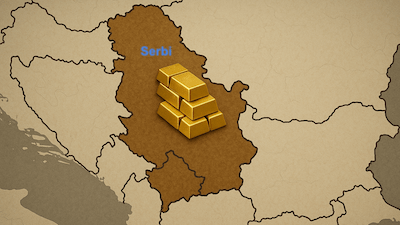(Mike Maharrey, Money Metals News Service) The National Bank of Serbia recently announced that it will hold all its gold reserves within its own borders.
Serbia holds 50.5 tonnes of gold, valued at roughly $6 billion.
The country began repatriating its gold in 2021, “an environment of increased global uncertainty,” according to statements by a bank official during a Q&A session.
“By returning gold to the country, the National Bank of Serbia sought to increase the availability and security of gold reserves in periods of crisis and uncertainty.”
All of Serbia’s gold is now stored in Belgrade, except for 5 tonnes currently held in Swiss vaults. The National Bank of Serbia plans to bring that gold home “as soon as possible,” making Serbia the first Eastern European country to store all its gold within its own borders.
Bank officials say they weighed the pros and cons of repatriating its gold, noting that it is easier to sell and lend gold when it is stored in market hubs. Ultimately, they decided the security of holding their gold at home outweighed that convenience.
The Serbs have also been expanding their gold holdings. The National Bank of Serbia has increased its gold reserves by 36 tonnes since 2019, buying about 17 tonnes from abroad and purchasing 19 tonnes from Zijin Mining Group Co.’s local unit.
Serbia is one of a growing number of central banks that are growing their gold reserves. Central banks globally bought over 1,000 tonnes of gold each of the last three years. To put that into perspective, central bank gold reserves increased by an average of just 473 tonnes annually between 2010 and 2021.
A Bloomberg report noted that the pace of central bank gold accumulation doubled after the U.S. and its Western allies imposed stiff sanctions on Russia after its invasion of Ukraine, “highlighting the political risk of holding dollar and euro-denominated assets.”
The report also pointed out that storing gold domestically also “shields them from this kind of interference.”
The Growing Gold Repatriation Trend
Serbia is one of many countries that have brought gold back home in recent years.
Jan Nieuwenhuijs recently reported that the share of global official gold reserves not stored at the Federal Reserve Bank in New York (FRBNY) and the Bank of England (BOE) in London has reached 78 percent in 2024, from 51 percent in 1972.
Most recently, India brought home another 100 tonnes of gold in 2024, following the repatriation of 100 tonnes the previous year.
In 2019, Poland brought home 100 tons of gold. Hungary and Romania also repatriated some of their gold reserves around that same time. In the summer of 2017, Germany completed a project, returning roughly half of its gold reserves back inside its borders. In 2015, Australia launched efforts to bring half of its reserves home. The Netherlands and Belgium have also initiated repatriation programs.
When Poland brought its gold home, National Bank of Poland Governor Adam Glapiński said that gold “symbolizes the strength of the country.”
This year, a growing number of people in Germany are calling for the Bundesbank to bring all of the German gold home.
There is speculation that other central banks have moved gold out of New York, but a lack of transparency on the part of the New York Fed makes confirmation difficult.
Last year, Fed Chairman Jerome Powell evaded questions about the central bank’s foreign gold holdings posed by Rep. Alex Mooney (R-W.Va). The U.S. central bank has also declined to comply with a Freedom of Information Act request for records about such holdings.
As investigative reporter Ken Silva wrote, Headline USA filed a FOIA request with the Fed for records reflecting how much gold the Federal Reserve Bank of New York currently holds in its vault, as well as records reflecting the ownership stake that each of FRBNY’s central bank/government clients has in that gold following Powell’s evasive response. The FOIA request also sought records about the Fed’s gold holdings before Russia’s February 2022 invasion of Ukraine.
The Fed denied the request.
This gold repatriation trend underscores the importance of holding physical gold free from counterparty risk.
Anxiety has increased given the way the U.S. has weaponized the dollar as a foreign policy tool. This has made many world leaders wary of keeping financial assets outside of their direct control.
According to a World Gold Council survey, a “substantial share” of central banks expressed concern about potential sanctions after the U.S. and other Western countries froze almost half of Russia’s $650 billion gold and forex reserves in the wake of its invasion of Ukraine. According to the WGC, 68 percent of the banks surveyed said they plan to keep their gold reserve within their country’s borders. This was up from 50 percent in 2020.
One anonymously quoted central bank official told Reuters, “We did have it [gold] held in London… but now we’ve transferred it back to our country to hold as a safe haven asset and to keep it safe.”
Invesco’s head of official institutions, Rod Ringrow, told Reuters this reflects a widely held view.
“‘If it’s my gold, then I want it in my country,’ has been the mantra we have seen in the last year or so.”
Mike Maharrey is a journalist and market analyst for Money Metals with over a decade of experience in precious metals. He holds a BS in accounting from the University of Kentucky and a BA in journalism from the University of South Florida.

